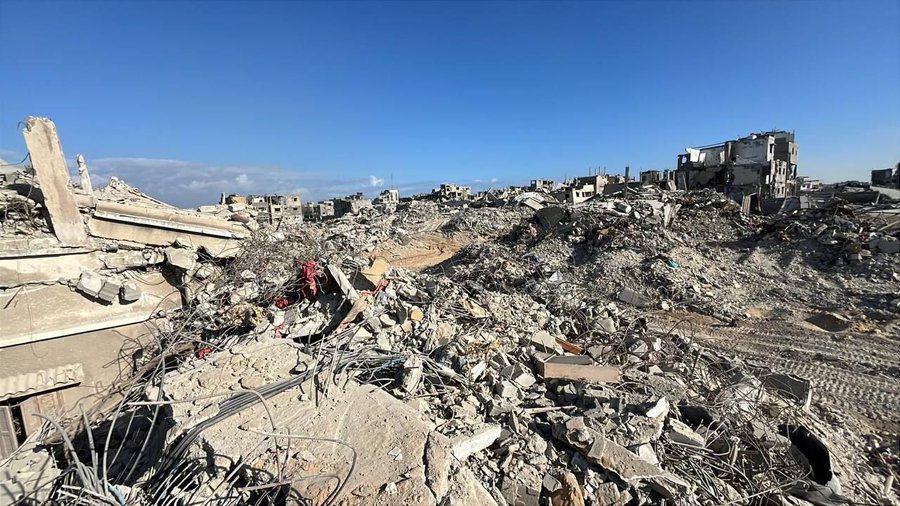The Gazans living between hope and 80 years of lies and destruction
Shaimaa Eid is a journalist based in Gaza.
Help support Shaimaa to survive the genocide and continue to work as a journalist by donating to her directly: Shaimaa has just published a booklet “Testimonies of Hunger, Destruction, and Massacres – The War Through the Eyes of Gaza’s Inhabitants”. You can obtain it HERE
Photo: Shaimaa Eid – This is what remains of Shaimaa’s family house in Sheikh Radwan
Amid tents engulfed by sand and endless scenes of devastation, the displaced in Al-Mawasi, Khan Younis, are experiencing a moment of relief laced with caution, fearing the possible return of war.
After two years of war that tore Gaza apart and scorched its dreams, the recent ceasefire has temporarily halted the bloodshed. Yet, it has also opened the door to pressing questions about the future, especially in light of the “Trump Plan,” which proposes appointing Tony Blair to oversee the postwar phase in the Strip.
On the ground, residents of Al-Mawasi do not seem to share the same sentiment. While some welcomed the end of the bombardment, others view the plan as a new form of guardianship over their fate. Many remain caught between hope and fear that the truce may be nothing more than a brief pause before another round of hell, especially after Hamas handed over all remaining living captives.
In a sprawling camp on the outskirts of Al-Mawasi, displaced woman Fathia Al-Farra, 60, from East Khan Younis whose home was destroyed by the occupation sits outside her modest tent, staring into the horizon and quietly says: “The bombing has stopped, yes, but we don’t know if it’s really over. This isn’t the first time we’ve heard of a ceasefire, only to suddenly wake up to the sound of planes.”
She continues with worry: “We want to rest, but we don’t trust. Peace cannot be made by those who helped destroy our homes.”
Around her, her children are busy with a simple game made from scraps of plastic, while aid convoys pass by carrying bags of flour. The joy of calm here is unlike any celebration; it feels more like a brief gasp of breath after a long drowning.
Tony Blair: A Name That Sparks Controversy
In the small market along both sides of the Mawasi Al-Qarara road, voices unite in rejecting the recently circulated “Trump Plan”” regarding Blair’s rule.
Mouein Qudeih, 35, a displaced person from Khan Younis, clearly expresses his anger: “Tony Blair was a partner in many wars in the region. So how can he be the one to govern Gaza today? Has he transformed from a warmonger to a peacemaker?”
Asmaa Al-Barai, 33, a mother of three who was displaced from Gaza and lost her home, says: “People here want to believe in any glimmer of hope. Even if that hope is fragile, we will hold on to it for a little while. But it will never come at the cost of our freedom. We want governance to be Palestinian and only Palestinian.”
Caught between doubt and acceptance about the end of the war, many stand uncertain before a fundamental question: Can any agreement succeed while the occupation persists?
Young activist Alaa Ghanem (24) says: “As long as the occupation continues, everything proposed is not a solution but crisis management. There can be no talk of peace while we have no land and no freedom.”
Al-Mawasi After the Calm: Catastrophic Living Conditions and Severe Overcrowding
Despite the ceasefire, the humanitarian situation in Al-Mawasi remains catastrophic.
The area, which has become a refuge for hundreds of thousands of displaced people, suffers from severe overcrowding and a critical shortage of basic services.
Nader Al-Abadleh (45), a camp coordinator, says: “What Israel allows in so far in terms of aid is nowhere near enough for this huge number of displaced people. Water is extremely scarce, and services are nearly nonexistent.”
A brief tour of the camp reveals long lines in front of a single water tank, and piles of garbage surrounding the tents.
The air is thick with dust and the stench of waste, and children play barefoot on ground unfit for habitation.
Umm Fares Al-Masri (67), displaced from Beit Hanoun, says: “They want us to forget our homes and accept these tents as our new homeland. But we will not forget. We are here only temporarily – we will return one day.”
Between Hope and Fear
Hope is a word that frequently surfaces in people’s conversations, yet it is wrapped in fear – fear of being deceived again, as happened after the first truce. Mahmoud Salim (41), a teacher who lost his school in the bombings, articulates this feeling clearly: “We live in a space between hope and fear. We want to believe this time is different, but we know the occupation hasn’t changed its behavior.”
He adds, “Real peace isn’t imposed from the outside; it begins when we can live freely on our land.”
Meanwhile, (9-year-old) Adam sums it up with striking innocence: “I just want to go back to school… as long as they don’t bomb us.”
Gaza Between a Truce and a Plan
Today, Gaza appears suspended between a fragile truce and an ambiguous plan whose full details remain unknown to its residents.
For people who have lost their homes and loved ones, the demands are modest: simply a normal life without fear.
But uncertainty surrounds everything, from the nature of future governance to the fate of reconstruction, and even the limits of this temporary calm.
At the end of the tour, displaced resident Basel Abu Mustafa says:
“We don’t need Tony Blair or Trump. We need the world’s conscience and our right to live freely on our land, not temporarily.”
In Al-Mawasi, Khan Younis, where sand meets sea and tears meet hope, Gaza is still waiting for one answer:
Is this calm the beginning of real peace, or just another chapter in a truce on the edge of war?



Be the first to comment